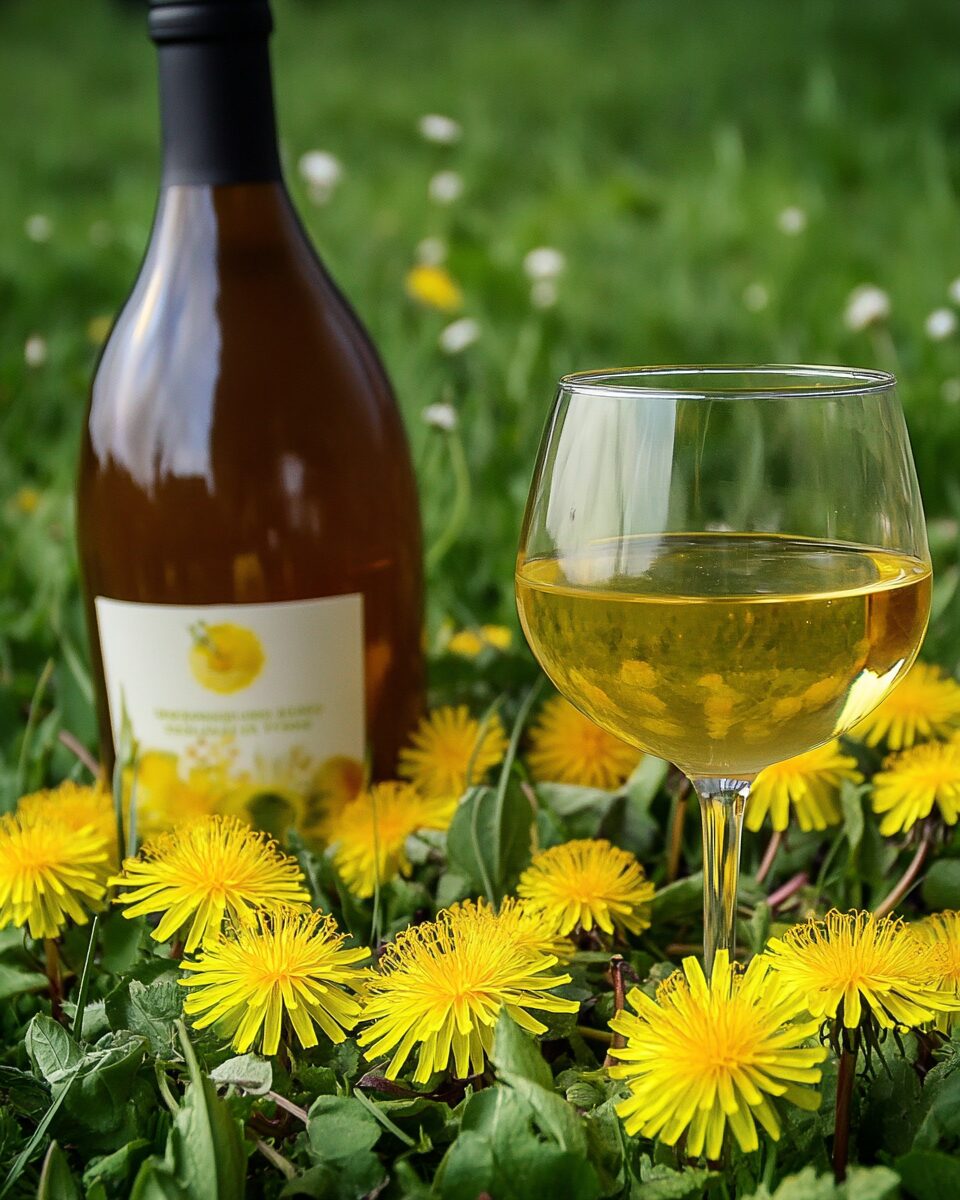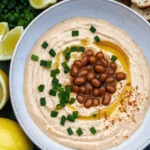This traditional dandelion wine recipe transforms humble dandelion petals into a rich, golden beverage with citrus undertones. Often described as warming and reminiscent of a fine brandy, it’s a delightful way to capture the essence of spring in a bottle.
FULL RECIPE
Ingredients
- 3 quarts dandelion petals (yellow parts only)
- 1 gallon water
- 2 oranges with peel, preferably organic
- 1 lemon with peel, preferably organic
- 3 pounds sugar
- 1 package wine yeast or champagne yeast
- 1 pound raisins, preferably organic
Directions:
- Harvest dandelion blossoms on a sunny day when fully open. Remove all green parts, retaining only the yellow petals.
- Boil the water and pour it over the petals in a large non-reactive container. Cover with a clean towel and let steep for 3 days, stirring daily to keep petals submerged.
- Zest half of the orange and lemon peels, avoiding the white pith. Peel the remaining rind in thin strips. Slice the peeled fruits into thin rounds.
- Add the citrus zest to the steeped petals and bring the mixture to a boil. Remove from heat, strain out solids, and stir in sugar until dissolved. Allow to cool to room temperature.
- Add the sliced citrus fruits, raisins, and yeast to the cooled liquid. Transfer to a fermentation vessel, covering with a clean cloth secured with a rubber band. Stir daily.
- After 1–2 weeks, when bubbling ceases, strain the liquid through multiple layers of cheesecloth to remove solids.
- Transfer the wine to clean bottles, seal, and store in a cool, dark place for at least 6 months before consuming.
Nutritional Information
- Calories: 180
- Carbohydrates: 30g
- Sugars: 28g
- Alcohol by Volume (ABV): 12–13%
Historical Significance of Dandelion Wine
Dandelion wine boasts a rich history, with its origins tracing back to ancient civilizations such as the Greeks, Romans, Egyptians, Chinese, and Persians. These cultures valued dandelions for their medicinal properties and nutritional benefits. The Romans, for instance, consumed the plant for its health advantages and introduced it to the Gauls and Celts. In ancient Egypt, dandelions were used to treat kidney and stomach disorders.
Cultural and Regional Traditions
Dandelion wine holds a special place in various cultures, particularly in regions where the plant is abundant. In Vineland, New Jersey, known as the “Dandelion Capital of the World,” an annual seven-course dandelion dinner is held each spring, featuring dishes like dandelion meatballs, salads, raviolis, and, of course, dandelion wine. This celebration underscores the community’s appreciation for the plant’s versatility and significance. Such traditions highlight the enduring cultural relevance of dandelion wine and its role in bringing communities together.
Medicinal and Nutritional Benefits
Dandelions are renowned for their health-promoting properties. They are rich in essential vitamins such as A, C, and K, and minerals including potassium, iron, and calcium. These nutrients contribute to various bodily functions, from supporting vision and immune health to aiding in blood clotting and bone strength. Additionally, dandelions possess diuretic properties, which can assist in detoxifying the body and promoting kidney function. The plant’s antioxidant content further supports overall health by combating oxidative stress.
Flavor Profile and Taste Experience
Dandelion wine offers a unique flavor profile that captures the essence of spring. The wine typically presents a bright, floral taste with subtle sweetness and citrus undertones. Some variations may exhibit a hint of bitterness, reminiscent of mead or a dry white wine. The inclusion of ingredients like raisins and citrus zest enhances the complexity of flavors, resulting in a refreshing and aromatic beverage.
Fermentation Process and Duration
The fermentation process for dandelion wine is a patient endeavor, often taking about two years to achieve optimal flavor. After the initial fermentation, which may last several weeks, the wine is typically aged to allow flavors to mature and mellow. This extended fermentation period contributes to the wine’s depth and character, making the wait worthwhile for enthusiasts seeking a distinctive homemade beverage.
Harvesting and Preparation Tips
For the best results, dandelion flowers should be harvested on a bright, sunny day when they are fully open. It’s crucial to ensure that the flowers have not been exposed to pesticides or other contaminants. When preparing the flowers for wine, only the yellow petals should be used, as the green parts can impart bitterness to the final product. Meticulous cleaning and preparation of the petals are essential steps in crafting a high-quality dandelion wine.
Incorporating Additional Flavors
While traditional dandelion wine recipes focus on the natural flavors of the petals, some variations incorporate additional ingredients to enhance the taste. Spices such as cloves and ground ginger can add warmth and complexity, while citrus juices like lime can introduce a zesty brightness. Experimenting with these additions allows for personalized flavor profiles and can elevate the overall drinking experience.
Storage and Aging Recommendations
Proper storage is vital to preserving the quality of dandelion wine. The wine should be stored in a cool, dry place away from direct sunlight, ideally in dark-colored bottles to protect against light exposure. While dandelion wine can be enjoyed shortly after fermentation, aging it for several months or even years can enhance its flavor and smoothness. Patience in the aging process often results in a more refined and enjoyable beverage.
Alcohol Content and Consumption
The alcohol content of dandelion wine typically ranges between 10% and 13%, depending on factors such as sugar content and fermentation duration. This moderate alcohol level makes it comparable to many commercial white wines. As with all alcoholic beverages, it’s important to consume dandelion wine responsibly and be mindful of its potency, especially when sharing with others.
Environmental and Foraging Considerations
Foraging for dandelions is an eco-friendly practice that encourages sustainable use of natural resources. By harvesting dandelions from untreated areas, individuals can create a connection with their environment and appreciate the abundance of nature. This practice not only provides ingredients for homemade wine but also fosters a deeper understanding of local ecosystems and the importance of biodiversity.
Community and Social Aspects
The process of making dandelion wine can be a communal activity that brings people together. From foraging for flowers to sharing the final product, each step offers opportunities for collaboration and bonding. Community events centered around dandelion wine, such as festivals and tastings, celebrate the craftsmanship involved and the enjoyment of homemade creations.
Pairing Dandelion Wine with Food
Dandelion wine pairs well with a variety of foods, especially those that complement its floral and slightly sweet flavor profile. It is a great accompaniment to cheeses, particularly sharp or tangy varieties, as well as fruits like apples and pears. For a unique pairing, serve dandelion wine with light seafood dishes or poultry, where its citrus undertones can balance the richness of the food.
Dandelion Wine for Special Occasions
Dandelion wine is a delightful beverage for special occasions, particularly during the spring and summer months when dandelions are in bloom. It makes a unique addition to gatherings such as picnics, barbecues, or holiday celebrations. The process of making and sharing dandelion wine can also become a cherished tradition for families and friends to enjoy year after year.
Exploring Dandelion Wine Variations
While the basic recipe for dandelion wine remains largely consistent, many variations exist. Some individuals may opt to experiment with different fruits, such as apples or berries, to create a more robust and fruity wine. Others might incorporate herbs like mint or lavender for an aromatic twist. The endless possibilities make dandelion wine a versatile drink that can be tailored to suit personal tastes.
Using Dandelion Wine in Cocktails
Dandelion wine can also be used as an ingredient in various cocktails. Its unique flavor adds complexity to mixed drinks, whether used as a base or combined with other spirits. Try pairing it with gin, vodka, or rum to create refreshing beverages that highlight its floral notes. Dandelion wine also works well in punches, providing a light and intriguing twist on traditional recipes.
Making Dandelion Wine with Family
Making dandelion wine can be an excellent family activity that brings together multiple generations. Children can help with the harvesting of dandelion flowers, while adults manage the preparation and fermentation processes. This shared activity not only creates memories but also teaches valuable skills related to food production, sustainability, and patience.
Dandelion Wine and Sustainability
One of the key benefits of making dandelion wine is its emphasis on sustainability. Dandelions are abundant, and they grow in many areas without the need for fertilizers or pesticides. By foraging for dandelions and using them in wine production, individuals can reduce their reliance on commercially produced ingredients, contributing to a more sustainable lifestyle.
Dandelion Wine and Its Popularity in Modern Times
While dandelion wine was once a popular homemade beverage, it has seen a resurgence in recent years as more people embrace artisanal and homemade products. With a growing interest in traditional cooking and foraging, dandelion wine has regained its status as a beloved drink for those seeking unique and natural alternatives to mass-produced wines.
Conclusion
Dandelion wine is more than just a beverage—it’s a celebration of nature, tradition, and community. Whether made for personal enjoyment or shared with friends and family, it offers a flavorful and meaningful way to embrace the changing seasons. By exploring its rich history, nutritional benefits, and unique flavors, you can truly appreciate the artistry involved in creating this timeless drink. So, next spring, when the dandelions bloom, consider crafting a batch of your own dandelion wine, and enjoy the fruits of your labor as you raise a glass to this wonderful tradition.






